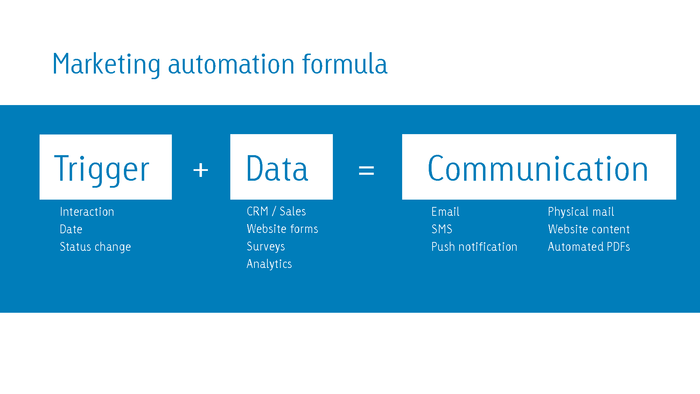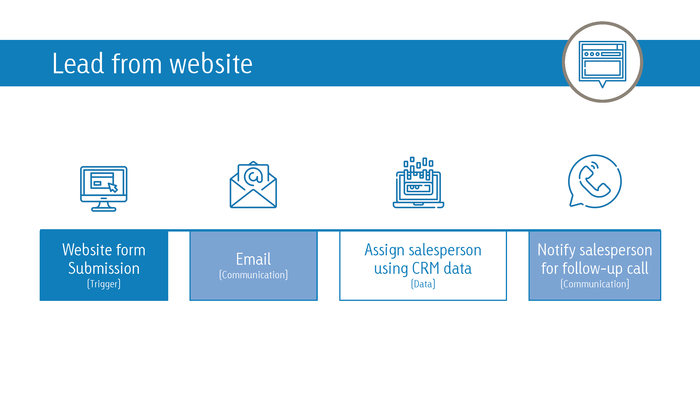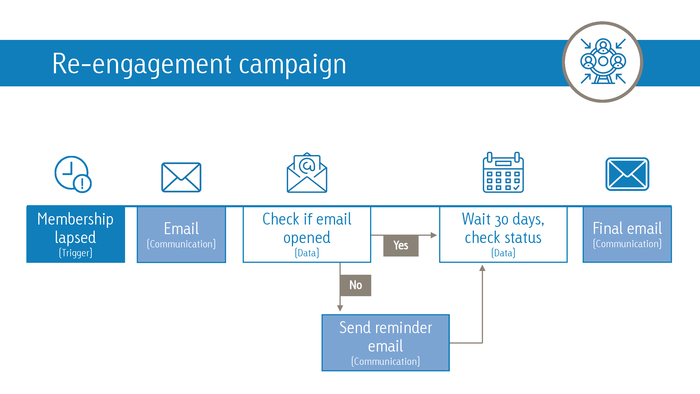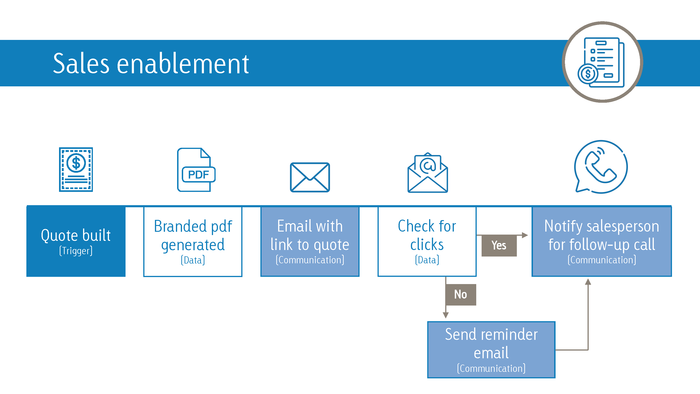Marketing automation is a big term that can mean a lot of different things to different people. Some hear marketing automation and immediately think of automated emails. Others think of generating automated PDFs. Still others think more about the behind-the-scenes integrations and data sources. Marketing automation is all of those things and more.
On top of that, we know there is often a gap between knowing what marketing automation is and knowing how to implement it. We’re going to close that gap for you by giving you a no-nonsense explanation of marketing automation and the ways you can use it.
Marketing automation explained
According to Salesforce, marketing automation is technology that manages marketing processes and multifunctional campaigns across multiple channels automatically. The general idea is to use automated processes to smoothly take data from multiple sources and produce communication pieces with little to no need for manual work.
Salesforce goes on to explain marketing automation this way:
With marketing automation, businesses can target customers with automated messages across email, web, social, and text. Messages are sent automatically, according to sets of instructions called workflows. Workflows may be defined by templates, custom-built from scratch, or modified mid-campaign to achieve better results.
In our experience, automating and personalizing SMS text messages, emails, reports, and proposals through channels like email service providers, CRMs, websites, or sales apps has the power to generate and nurture leads, close sales, and reduce overhead costs.
How marketing automation works
In its simplest form, marketing automation can be boiled down to this formula below. Trigger + data = communication piece.

A trigger starts the automation process, then data is used to make decisions and create the communication pieces. And finally, in most cases, it sends those communication pieces out to the targeted audience.
Triggers
What is a trigger? A trigger is what signals to the automation system that something needs to happen. There are three types: interaction, date-based, and status change.
Examples of an interaction trigger include when someone visits a certain page on your website, fills out a form, opens an email, or calls customer service.
The second date-based trigger initiates on a specific date. It could be connected to a campaign launch, a customer’s birthday, or a membership renewal date.
The third trigger type, status change, could be a trigger that watches a customer’s information and activates once a status gets updated. For example, if someone moves from prospect to client or active member to termed member.
Data
Data is the glue that holds automations together. It’s important to know what data you have, where that data lives, and what data you may need to be collecting in the future for your marketing automation activities.
One place your data may live is in a CRM tool that is updated by your sales team. Additionally, information may come from website forms, surveys, or website and email analytics. The information from all of these sources is used to determine when triggers are executed, what automation people are added to, and what the final communication piece includes.
Communication pieces
As stated earlier, common communication pieces include emails, text messages, push notifications, physical mailings, and website content. You can even automate PDF generation. For example, financial companies can update fact sheets with real-time financial data, or sales teams can generate personalized quotes using the company’s cost database. With marketing automation, you can create and deliver these communication pieces with little to no manual effort making them repeatable, efficient, and cost saving.
Automation examples
So, what are some real-world examples of marketing automation? We’re going to outline three common workflows below.
This first example shows a simple website to lead automation.

In this case, someone comes to your website, fills out a form, and receives an email immediately. Then using CRM data, a salesperson is assigned, and a notification is sent to that salesperson to trigger a follow-up call.
The trigger in this illustration is the website form submission. Data is being taken from the CRM and used to assign a salesperson. And the communication pieces are an email and a follow-up call.
Our second example represents a re-engagement campaign for lapsed membership.

Here we’re first watching to see if a membership has lapsed, and if it has, we send them an email to try and re-engage the member.
After a certain amount of time has passed, we check to see if the email was opened. If it hasn’t been opened, we send a follow-up email to remind the member. Either way, this automation waits 30 days and checks the membership status again to see if anything changed. If it hasn’t, a final email is sent.
In this example, the trigger is a membership status lapsing. Email analytic data is used to determine if the emails were opened, and CRM data reveals changes to status. The communication pieces are an initial email, a reminder email, and a follow-up email.
Our third example showcases a personalized quote for services automatically generated by a sales support app.

In this automation, a quote is built out in the app by a salesperson; then the app generates a branded PDF and sends it out to a customer with a link to that PDF. From there, email analytics check to see if the customer has clicked on the PDF quote. If they haven’t, an email reminder is sent. Whether they clicked on the PDF or not, a notification is sent to the salesperson so they can initiate a follow-up call.
The trigger here is the quote generation. Data comes from the sales app to create the PDF, email analytics data checks for clicks, and CRM data is used to send the salesperson a notification.
The communication pieces are a branded PDF, an email with a quote, a reminder email, and a notification to make a follow-up call.

Email marketing + Salesforce integration
See how we helped build an email marketing strategy with Salesforce integrations for Priority Health.
The benefits of marketing automation
Now that we’ve worked through the functional details of what marketing automation is, it’s important to understand why marketing automation benefits you and your organization.
The buying process has changed—especially in the last year—and companies need to adapt to buyer communication preferences. Today’s buyers are anywhere from 60-90% of the way through the purchasing process before they reach out to you. That means your buyers are interacting with your content long before they ever engage with you directly. They expect a better, more integrated digital experience to solve their problems without having to speak to you or a salesperson.
Speaking of prospective customers, did you know that half of all leads are mismanaged? Studies show[/EXLINK] that 54% of high-quality leads received through a company’s website never get a response. That’s a huge problem. Additionally, of the 50% of leads that do get a response, 78% of those responses take more than an hour. That timeframe might seem okay, but research shows that you have five minutes or less to send a response before you’ve lost your customer’s attention.
Besides lead nurturing, marketing automation has benefits for your sales and marketing teams too. For your sales team, this translates to more qualified leads. According to research conducted by organizational research leader Forrester, companies that excel at lead nurturing generate 50% more sales-ready leads at a 33% lower cost.
Marketing automation helps sales and marketing work collaboratively to connect digital touch points to the CRM, which in turn provides sales leads more efficiently. One report shows a 451% increase in qualified leads and a 14.5% increase in sales productivity for those who implement lead nurturing well. Not only will your salespeople receive more qualified leads, they’ll also have more information in their hands about those leads.
And last but not least, marketing automation is good for marketing. Automation saves time and money in the long run because you set it up once and then processes run on their own. [EXLINK ‘939’]Recent studies reveal that implementing marketing automation can lead to a 12.2% reduction in marketing overhead. Not only that, but it sets marketing teams up to focus on continuous improvement instead of building one-off communications. It’s a great way to get your marketing team thinking about a strategy-based approach versus a project-by-project approach.
Step-by-step process
So, we’ve convinced you, right? Marketing automation is worth it. It’s time to talk about how to make it happen. Generally, people immediately want to start talking about the creative design and content right away, but there are so many steps to consider before you get to the finished product.
The following nine steps walk you through what it takes to build a marketing automation solution.
Step 1: Define your opportunity
Start by looking at your current business environment and identifying areas for improvement. This means looking at your buyer’s journey and analyzing a few things.
- Notice areas where you have a lot of manual updates happening
- Search for where buyers might be falling out of the funnel
- Determine if there is any disconnect between information the customer needs and the information they have
Step 2: Determine your goal
Once you’ve identified the opportunity you want to pursue, you need to set a specific goal the automation will accomplish. After all, how will you know if your automation is successful without one? Your goal should be specific and measurable.
Step 3: Define your audience
Clearly defining your audience helps you understand what channels are needed to build the automation as well as what data is needed about the audience.
Step 4: Nail down your channels
Channels are both places that hold your data and places that are used to execute your messaging. Your CRM website, app, and email marketing platforms are all examples of channels you can leverage when executing a marketing automation.
Step 5: Identify your data needs
Now that the basics of your automation have been defined, it’s time to answer the big question: where is the data?
Answering this can take some time because once you identify what data you need, you may find the data doesn’t currently live where your marketing automation platform can access it. As a result, an important part of this step involves figuring out how to get that data where it needs to be in order to be used by the automation.
Step 6: Plan data and communication framework
This step involves building out a data visualization to show the flow of the data triggers and communication pieces involved in the automation. This is helpful as a planning step to make sure everything is properly articulated for the build, but it also serves as a documentation step for the sake of stakeholders. Seeing a visualization of the automation will help it come to life.
Step 7: Build communication pieces and framework
This is where it gets fun! Now that you’ve laid out a detailed plan and identified and located the data, it’s time to build out the automation. The build-out includes connecting data streams, creating the triggers, and crafting communication pieces such as emails, SMS messages, postcards, and PDFs.
Step 8: Test automation
With your automation built, you’ll need to run test subjects through the entire automation to make sure data is being managed the way you expect and the automation is triggered appropriately.
Step 9: Launch and continuously improve
Three, two, one, blast off! Everything you’ve done prior to this culminates on launch day. Celebrate and enjoy the fruits of your labor, but don’t stop there. One of the benefits of marketing automation is that, if you’ve built it to track the correct analytics, you can monitor its success and make adjustments as needed to improve results.
Common roadblocks and challenges
Unfortunately, this process isn’t without its roadblocks and challenges. But being aware of them ahead of time may help you avoid them altogether. We’ve identified five common challenges.
Challenge 1: Not using the right platform
This challenge has the potential to be the most expensive to remedy, and there are two ways we typically see this play out. First, you may find you don’t have a robust enough platform to perform the marketing automation you want. Maybe you don’t have a CRM to store your data, or the CRM you do have doesn’t integrate well with your automation system. You might have an intricate automation planned but find your platform doesn’t have the capabilities to handle it.
On the opposite end of the spectrum, you may find you have too much platform. It’s not uncommon for companies to purchase a Ferrari to do the job of a Honda. Big platforms promise big things. That $25,000 a month platform has a robust software, but without a plan in place to use all of the bells and whistles, you may end up only using a fraction of what’s available.
Make sure your decision is based on the automations you have planned and what’s needed to accomplish them. If all you want to do is send emails or execute simple automations, then you’d be better off with a lightweight product that only costs $50 a month.
Challenge 2: Not having access to the right data
Since data is the glue of an automated solution, not having the data you need in a usable form—or not having the data at all—is a huge hurdle to overcome. If your data isn’t in a usable form or lives on multiple systems, you will need to work with the teams that manage each data source to figure out how to translate it and integrate it into your automated marketing platform. This may require APIs, FTPs, RSS feeds, database queries, and/or data management platforms.
On the other hand, if you don’t have the data at all, this is more of a lead generation, customer acquisition, or tracking issue. You may need more robust intake forms, customer portals, or tracking to gather more information about your audiences.
Challenge 3: Not aligning sales and marketing
Due to organizational silos, it’s common for sales and marketing to have different understandings about where marketing ends and sales begins. And it’s your prospective customers who pay the price for this misalignment.
Solving this challenge requires transparent and honest conversations with internal teams. When our clients present with this issue, we often suggest that ddm conduct surveys or interviews on behalf of the sales and marketing teams. When misconceptions and truths are revealed, the work to mediate the situation can begin.
Challenge 4: Not having compelling content
Without compelling content your messages won’t connect with your audience, regardless of how timely those messages may be. Companies are competing for customers’ attention, and your message has to be relevant, empathetic, and, frankly, interesting to stand out in the noise.
Think about what your audience cares about not just what’s on your marketing agenda. Make sure content is useful and engaging. It must solve a problem, provide guidance, inform, or entertain.
Challenge 5: Not having the right people
Depending on the size of your team, you might not have the right people in-house to strategize, build automations, or write content. The solution is to look for third party help, like ddm. Our team assists some companies from start to finish, and others with just one piece of the puzzle. We fill in the gaps so you can focus on what your team does best.
The automation possibilities are endless
Marketing automation is not a one-size-fits-all solution. There are hundreds, maybe even thousands of options that can be implemented across all industries and within both internal and external audiences.
Marketing automation can support sales apps, increase membership renewals, update financial reports, acquire customer information, increase event attendance, share new product details, drive traffic to blog articles, communicate appointment updates, and inform distributors and partners. You get the idea. The possibilities are endless.
But the best marketing automation activities are the ones that meet your particular audience’s needs and enhance your company’s bottom line.

Mutual fund fact sheet automation
Learn how ddm works with financial clients to automate quarterly fact sheets.
Looking for more?
You’re not alone. In our marketing automation webinar, attendees asked some great questions about email personalization, purchased lists, and getting through spam filters. Watch the webinar replay to hear our answers.
